2019 Hotel Interior Design Trends
How are hoteliers keeping up with the competition and enhancing the guest experience from the inside? Here are some of the most popular 2019 hotel interior design trends.
The growth of the sharing economy, and Airbnb in particular, have forced hoteliers to step up their game. In addition to rethinking how they operate their businesses, they are updating and reshaping the look, feel and appeal of their locations. Wellness, eco-consciousness, authenticity, homeyness and the evolution of the lobby are among the 2019 hotel interior design trends being implemented at both independent hotel companies and chains.
Foremost, there is a renewed focus on the guest experience. “My four brands are all different, but they all focus on (understanding) who our customer is and relating to them. It’s not just about putting a head in a bed,” said Aliya Khan, vice president of global design strategies at Marriott International, where she oversees projects for AC Hotels, aloft, Moxy and Element brands.
Functional issues are addressed via efficient space planning, while hotel design, art and programming, on the other hand, must feel authentic to the locale, Kahn said. “For the business traveler, if the check-in isn’t seamless and efficient—or if people have to wait too long in line to get in an elevator—that’s a problem,” she said.
And then there is the ever-elusive wow factor. As Kahn put it: “How do we continue to impress and delight and surprise people when they see the whole world on HGTV and Instagram?”
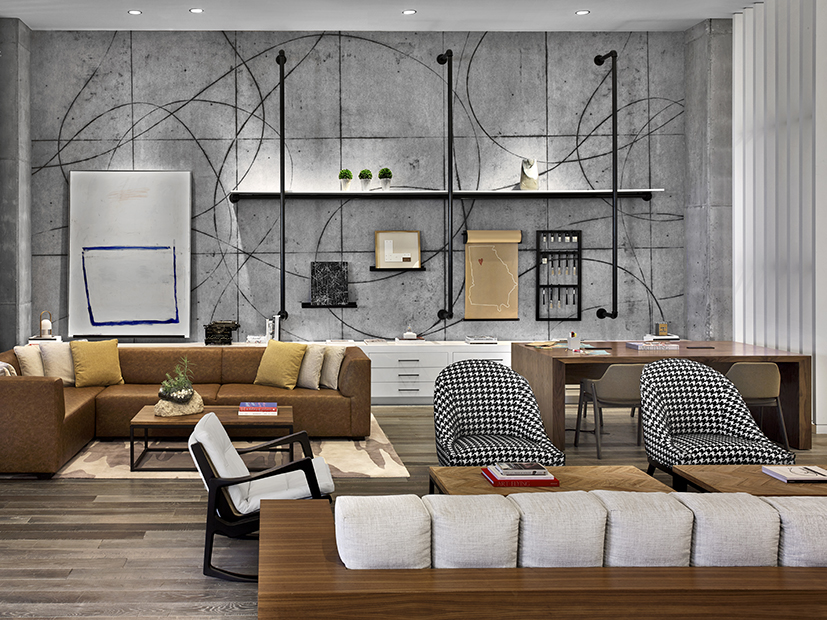
A lounge’s custom walnut-framed sofa integrates USB ports at Renaissance Atlanta Airport Gateway Hotel by Rottet Studio. Photo by Eric Laignel
Nature is the New Luxury
Key among 2019 hotel interior design trends, designers note, is an awareness of the environment outside the hotel and the natural world in general. Launched in 2015, Starwood Capital Group’s luxury lifestyle brand 1 Hotel was developed with the idea that those who travel the world also care about it. The brand celebrates nature, eco-conscious design and sustainable architecture at its Miami South Beach, Manhattan Central Park and Brooklyn Bridge properties.
At 1 Hotel Central Park in New York, the landscape design by Damien Harrison of Harrison Green begins with the ivy-covered facade of the corner property. The interior design by AvroKo Hospitality uses the building’s original industrial architecture as a reference point, bringing the outside in to feature the raw beauty and imperfections of natural materials. Wood, brick, marble, stone and glass sourced from local suppliers are blended with original riveted steel beams and concrete ceilings and natural elements. Upon arrival, guests find 16,000 fallen twigs artfully embedded into two large steel doors. On each floor, the number gests see when they exit the elevator is represented in a different artistic design using repurposed materials, such as penny nails or acorns. Preserved moss fills hallway niches. Guest rooms feature terrariums.
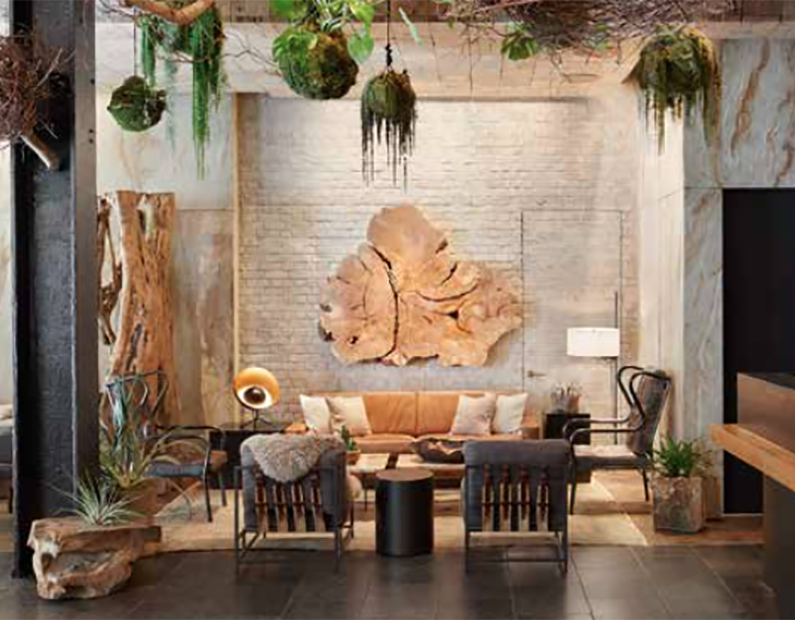
At 1 Hotel Central Park, interior design by AvroKo Hospitality uses original industrial architecture as a reference point while featuring the raw beauty of natural materials. Photo courtesy of 1 Hotel
Designing Healthy Spaces
Researchers at The American Society of Interior Designers have noted that globally hotel properties are enhancing the physical and mental health of their guests through design and amenity options. ASID’s report “Hospitality Design and Well-Being: Quality Sleep at Hotels” explores how hotel design can increase the likelihood of deep and restorative guest sleep.
Creating dark and quiet hotel rooms, providing personal choice―guests select between different pillows and control room temperature―and blocking excessive light are some of the functional design best practices gleaned from the ASID research.
“For years, I have thought about how to design a healthier hotel room,” said Lauren Rottet, FAIA, FIIDA, NCARB, founding principal & president of Rottet Studio.
Rottet, in fact, was raised by a doctor father who taught her a few tricks for how not to get sick when you travel. “Early in the design, we check to make sure the mechanical, plumbing and engineering are locating the building’s fresh air intake in the most pollution-free area as possible, and we encourage our owners to have a higher amount of outdoor air than required by code,” Rottet explained. “Of course, we do not use any materials that give off toxic emissions and are very careful in our paint and finish specifications.”
Good lighting is also important for maintaining eye health. “As most hotels go deck to deck without an interstitial space for ceiling lights, one must figure out how to get enough light in a room through table and floor lamps,” she added.
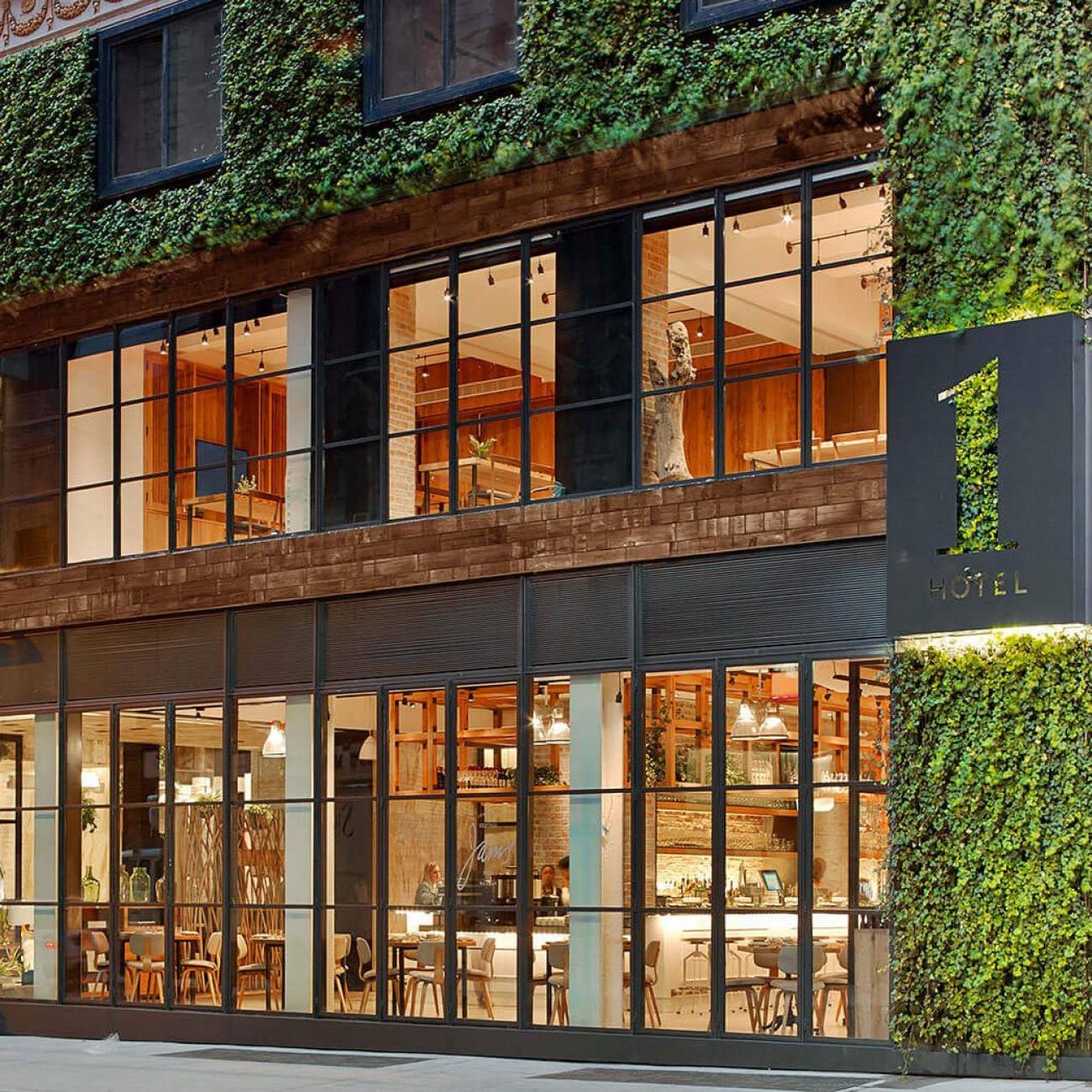
With its ivy-covered façade, 1 Hotel Central Park’s landscape design by Damien Harrison of Harrison Green pays homage to New York City’s iconic Central Park. Photo courtesy of 1 Hotel
Revealing Authenticity
Placemaking—instilling in users a sense of community, attachment and pride about where they live, work or recreate―is a phenomenon that has pervaded most types of real estate, so it is only natural that it be one of the top 2019 hotel interior design trends. Rottet Studio strives to incorporate placemaking by bringing authenticity of place to every hotel they design—whether it’s part of a multi-location brand or a one-of-a-kind boutique hotel. “In order to capture the feeling of a place, we dig deep into the specific site, not just the city. We research the history: Who lived there? What happened there? What is the community like now and what makes it unique?”
While five-star accommodations and great service are still in demand, they are no longer a guarantee of success. Travelers today want the experience, which is why quirky boutique elements are so popular. Even the luxury brands are presenting a more playful and casual persona. Rottet wonders, however, when seasoned travelers will begin to miss the glamour.
In the meantime, they are enjoying the new coworking environments available now in many hotels everywhere. “You travel for work, but you don’t want to stay in your room alone working, so you come downstairs to the lobby—or up to the roof—to work among others,” Rottet said. “The Ace Hotel started this trend with the lobby that encouraged hanging out all day. That trend has gone viral across all brands and stars. Now it is not just a place to take your laptop and send a few e-mails, but a full service WeWork-type environment where non-hotel guests might be officing and partaking of the hotel amenities.”
Increasingly, hotels are becoming city centers. They’re the place for locals to go on a Sunday afternoon for coffee or brunch or to have dinner, hear music and meet up with friends. According to Rottet, art in hotels has been a hotel décor trend for a while, but some hotels are going a step further and creating a cultural art experience for locals as well as guests. Some with permanent displays and others with rotating shows by respected art curators.
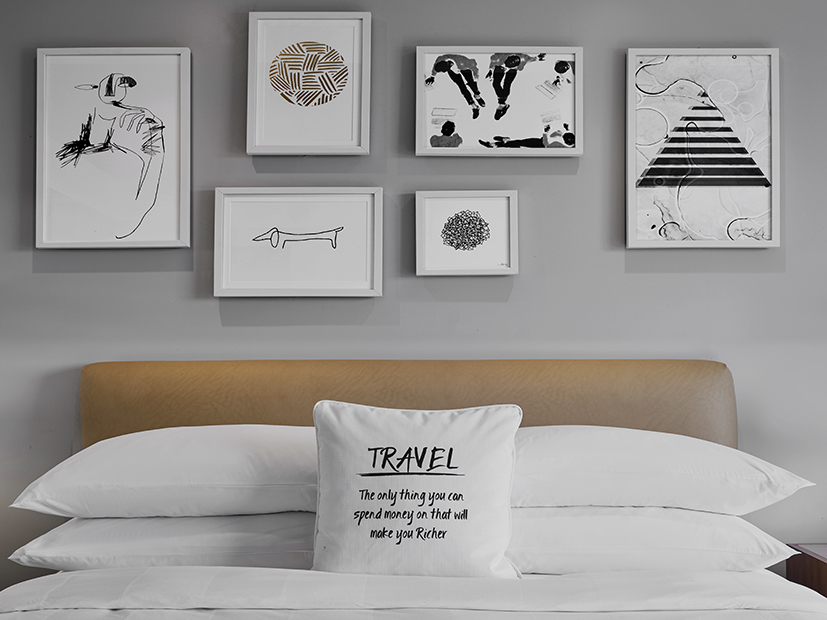
Residential touches enhance the guest experience in this standard guest room at Renaissance Atlanta Airport Gateway Hotel by Rottet Studio. Photography by Eric Laignel
Home Away from Home
Replicating residential elements is another popular hospitality design trend, according to Jessica Shaw, director of interior design at The Turett Collaborative in New York. “The color palettes we’ve been seeing have not been that distinct between residential and hospitality. In many cases, they’re interchangeable,” she said.
Shaw also sees an appreciation of simple geometry. “Pared-down Deco is very prevalent now in hospitality. The shapes that furniture is taking are echoing that quite a bit,” she added. In terms of materials, porcelain tile is popular because of its durability and interesting finishes. “It’s always something we’ve used in our hospitality projects. Now it’s having a softer, more residential look to it.”
Bathroom fixtures in hotels are also influenced by residential and Shaw observes that “Henry,” a line by Waterworks that is influenced by the connection of industry and art, seems to be everywhere. Waterworks describes Henry as easily transitioning between modern, traditional, utilitarian and classic settings. Black and gold finishes continue to prevail. “Certainly, they were very dominant in the last hotel we did in New York,” Shaw said.
The growing use of technology to communicate and reinforce design is another hotel décor trend. Wherever they travel in the world, guests’ personalized options can travel with them. These “portable hotel rooms,” as they are sometimes called, get to know your preferences and they follow you across the hotel brand. Technology has also enabled hoteliers to offer travelers self-serve concierge services and smart check in. Hoteliers are wary about jumping on board with all aspects of smart rooms, however, because, if that technology fails, it’s horrendous. Shaw said: “It’s great until it doesn’t work and then you’re left with a problem managing the hotel.”
And now, more than ever, a hotel’s website sets the tone for what the guest experience will be like. Shaw recalled: “There’s a hotel in Detroit that just opened and, on the splash page, you’re being led through the space by a dog (who is the guest). It’s his point of view walking you through a suite—and then he jumps up on the king-size bed and chills out on the foot of the bed.” The message is clear and inviting: You and your pet can make this hotel your home away from home.


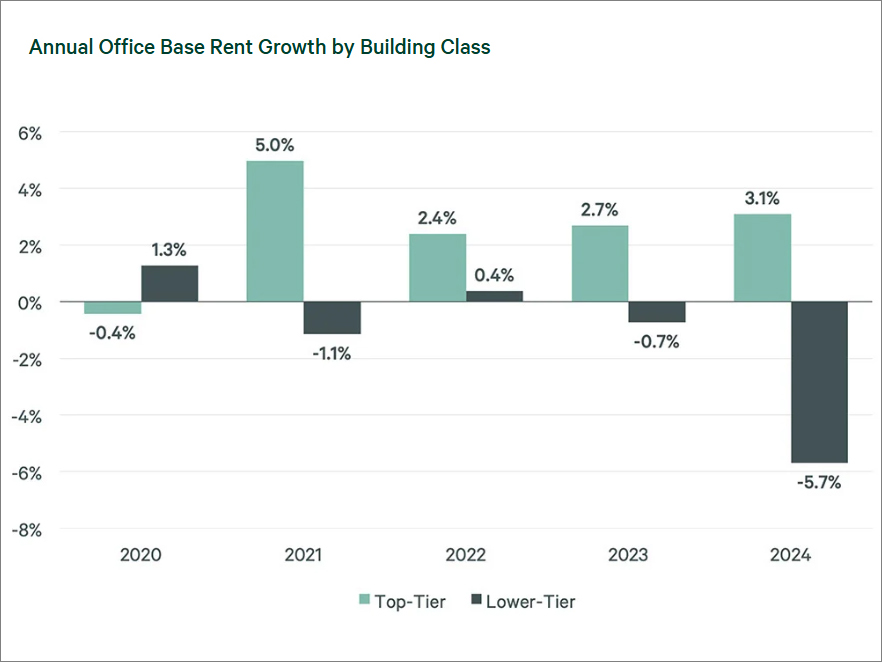
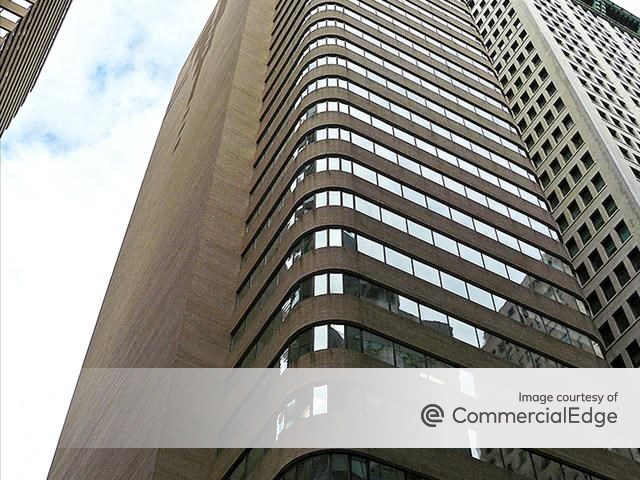



You must be logged in to post a comment.